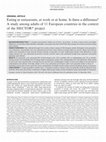Papers by Androniki Naska

European Journal of Clinical Nutrition, 2016
BACKGROUND/OBJECTIVES: To compare macronutrient intakes out of home-by location-to those at home ... more BACKGROUND/OBJECTIVES: To compare macronutrient intakes out of home-by location-to those at home and to investigate differences in total daily intakes between individuals consuming more than half of their daily energy out of home and those eating only at home. SUBJECTS/METHODS: Data collected through 24-h recalls or diaries among 23 766 European adults. Participants were grouped as 'non-substantial', 'intermediate' and 'very substantial out-of-home' eaters based on energy intake out of home. Mean macronutrient intakes were estimated at home and out of home (overall, at restaurants, at work). Study/cohort-specific mean differences in total intakes between the 'very substantial out-of-home' and the 'at-home' eaters were estimated through linear regression and pooled estimates were derived. RESULTS: At restaurants, men consumed 29% of their energy as fat, 15% as protein, 45% as carbohydrates and 11% as alcohol. Among women, fat contributed 33% of energy intake at restaurants, protein 16%, carbohydrates 45% and alcohol 6%. When eating at work, both sexes reported 30% of energy from fat and 55% from carbohydrates. Intakes at home were higher in fat and lower in carbohydrates and alcohol. Total daily intakes of the 'very substantial out-of-home' eaters were generally similar to those of individuals eating only at home, apart from lower carbohydrate and higher alcohol intakes among individuals eating at restaurants. CONCLUSIONS: In a large population of adults from 11 European countries, eating at work was generally similar to eating at home. Alcoholic drinks were the primary contributors of higher daily energy intakes among individuals eating substantially at restaurants.

British Journal of Nutrition, 2015
Eating out has been linked to the current obesity epidemic, but the evaluation of the extent to w... more Eating out has been linked to the current obesity epidemic, but the evaluation of the extent to which out of home (OH) dietary intakes are different from those at home (AH) is limited. Data collected among 8849 men and 14 277 women aged 35–64 years from the general population of eleven European countries through 24-h dietary recalls or food diaries were analysed to: (1) compare food consumption OH to those AH; (2) describe the characteristics of substantial OH eaters, defined as those who consumed 25 % or more of their total daily energy intake at OH locations. Logistic regression models were fit to identify personal characteristics associated with eating out. In both sexes, beverages, sugar, desserts, sweet and savoury bakery products were consumed more OH than AH. In some countries, men reported higher intakes of fish OH than AH. Overall, substantial OH eating was more common among men, the younger and the more educated participants, but was weakly associated with total energy int...
Basel ; Freiburg ; Paris ; London ; [et al.] : Karger, 2009
International journal of obesity (2005), 2011
The aim of this study was to examine the association of body mass index (BMI) and weight gain wit... more The aim of this study was to examine the association of body mass index (BMI) and weight gain with eating at restaurants and similar establishments or eating at work among 10 European countries of the European Prospective Investigation into Cancer and Nutrition (EPIC) study.

Frontiers in Nutrition
Recent advances in the field of nutrigenetics have provided evidence on how genetic variations ca... more Recent advances in the field of nutrigenetics have provided evidence on how genetic variations can impact the individuals' response to dietary intakes. An objective and reliable assessment of dietary exposures should rely on combinations of methodologies including frequency questionnaires, short-term recalls or records, together with biological samples to evaluate markers of intake or status and to identify genetic susceptibilities. In an attempt to present current knowledge on how genetic fingerprints contribute to an individual's nutritional status, we present a review of current literature describing associations between genetic variants and levels of well-established biomarkers of vitamin status in free-living and generally healthy individuals. Based on the outcomes of candidate gene, genome-wide-association studies and meta-analyses thereof, we have identified several single nucleotide polymorphisms (SNPs) involved in the vitamins' metabolic pathways. Polymorphisms ...

BMC medicine, Jan 8, 2017
Circulating osteoprotegerin (OPG), a member of the receptor activator of nuclear factor kappa-B (... more Circulating osteoprotegerin (OPG), a member of the receptor activator of nuclear factor kappa-B (RANK) axis, may influence breast cancer risk via its role as the decoy receptor for both the RANK ligand (RANKL) and tumor necrosis factor-related apoptosis-inducing ligand (TRAIL). Circulating OPG and breast cancer risk has been examined in only one prior study. A case-control study was nested in the European Prospective Investigation into Cancer and Nutrition (EPIC) cohort. A total of 2008 incident invasive breast cancer cases (estrogen receptor (ER)+, n = 1622; ER-, n = 386), matched 1:1 to controls, were included in the analysis. Women were predominantly postmenopausal at blood collection (77%); postmenopausal women included users and non-users of postmenopausal hormone therapy (HT). Serum OPG was quantified with an electrochemiluminescence assay. Relative risks (RRs) and 95% confidence intervals (CIs) were calculated using conditional logistic regression. The associations between OP...
European Journal of Cancer, 2011
PLoS ONE, 2012
Background: Socio-economic inequalities in mortality are observed at the country level in both No... more Background: Socio-economic inequalities in mortality are observed at the country level in both North America and Europe. The purpose of this work is to investigate the contribution of specific risk factors to social inequalities in cause-specific mortality using a large multi-country cohort of Europeans.

Background and aims: High glycemic load (GL) has been associated with increased coronary heart di... more Background and aims: High glycemic load (GL) has been associated with increased coronary heart disease (CHD) risk. We evaluated whether preference of low-GL foods conveys incre-mental benefits with respect to CHD, especially to people adhering to the traditional Mediterranean diet (MD). Methods and results: We analyzed data from the Greek European Prospective Investigation into Cancer and Nutrition, including 20,275 participants free of cardiovascular diseases, cancer, or diabetes at baseline and without incident diabetes. Subjects completed a validated, semi-quantitative food frequency questionnaire at enrollment. We calculated a 10-point MD adherence score and the dietary GL, and estimated hazard ratios (HRs) for CHD incidence and mortality through Cox proportional hazard regression. After a median follow-up of 10.4 years, 417 participants developed CHD, and 162 died from the disease. A significant positive association of GL with CHD incidence emerged (HR for the highest versus the lowest tertile Z 1.41, 95% confidence interval, CI: 1.05e1.90). HRs for CHD mortality exceeded unity but were not statistically significant. The association with GL was stronger among subjects with higher body mass index. High adherence to MD with low/moderate GL was associated with lower risk of CHD incidence (HR Z 0.61, CI: 0.39e0.95) and mortality (HR Z 0.47, 95% CI: 0.23e96). Conclusion: High dietary GL increases the risk of CHD. Compared to a high GL diet with subop-timal adherence to the traditional Mediterranean pattern, a low/moderate GL diet that also conforms to the traditional MD principles could lead to a 40% reduced risk for CHD, and over 50% reduced risk for death from CHD.

Objective: To evaluate how well respondents perceive digital images of food portions commonly con... more Objective: To evaluate how well respondents perceive digital images of food portions commonly consumed in Greece.
Design: The picture series was defined on the basis of usual dietary intakes assessed in earlier large-scale studies in Greece. The evaluation included 2218 pre-weighed
actual portions shown to participants, who were subsequently asked to link each portion to a food picture. Mean differences between picture numbers selected and portions actually shown were compared using the Wilcoxon paired signed-rank test.
The effect of personal characteristics on participants’ selections was evaluated through unpaired t tests (sex and school years) or through Tukey–Kramer pairwise comparisons (age and food groups).
Setting: Testing of participants’ perception of digital food images used in the Greek national nutrition survey.
Subjects: Individuals (n 103, 61% females) aged 12 years and over, selected on the basis of the target population of the Greek nutrition survey using convenience sampling.
Results: Individuals selected the correct or adjacent image in about 90% of the assessments and tended to overestimate small and underestimate large quantities.
Photographs of Greek traditional pies and meat-based pastry dishes led participants to perceive the amounts in the photos larger than they actually were. Adolescents were more prone to underestimating food quantities through the pictures.
Conclusions: The digital food atlas appears generally suitable to be used for the estimation of average food intakes in large-scale dietary surveys in Greece. However, individuals who consistently consume only small or only large food portions may have biased perceptions in relation to others.

Epigenomics, Jan 11, 2016
Epigenetic changes may occur in response to environmental stressors, and an altered epigenome pat... more Epigenetic changes may occur in response to environmental stressors, and an altered epigenome pattern may represent a stable signature of environmental exposure. Here, we examined the potential of DNA methylation changes in 910 prediagnostic peripheral blood samples as a marker of exposure to tobacco smoke in a large multinational cohort. We identified 748 CpG sites that were differentially methylated between smokers and nonsmokers, among which we identified novel regionally clustered CpGs associated with active smoking. Importantly, we found a marked reversibility of methylation changes after smoking cessation, although specific genes remained differentially methylated up to 22 years after cessation. Our study has comprehensively cataloged the smoking-associated DNA methylation alterations and showed that these alterations are reversible after smoking cessation.

European Journal of Nutrition, 2016
Acrylamide was classified as &amp... more Acrylamide was classified as 'probably carcinogenic' to humans in 1994 by the International Agency for Research on Cancer. In 2002, public health concern increased when acrylamide was identified in starchy, plant-based foods, processed at high temperatures. The purpose of this study was to identify which food groups and lifestyle variables were determinants of hemoglobin adduct concentrations of acrylamide (HbAA) and glycidamide (HbGA) in 801 non-smoking postmenopausal women from eight countries in the European Prospective Investigation into Cancer and Nutrition (EPIC) cohort. Biomarkers of internal exposure were measured in red blood cells (collected at baseline) by high-performance liquid chromatography/tandem mass spectrometry (HPLC/MS/MS) . In this cross-sectional analysis, four dependent variables were evaluated: HbAA, HbGA, sum of total adducts (HbAA + HbGA), and their ratio (HbGA/HbAA). Simple and multiple regression analyses were used to identify determinants of the four outcome variables. All dependent variables (except HbGA/HbAA) and all independent variables were log-transformed (log2) to improve normality. Median (25th-75th percentile) HbAA and HbGA adduct levels were 41.3 (32.8-53.1) pmol/g Hb and 34.2 (25.4-46.9) pmol/g Hb, respectively. The main food group determinants of HbAA, HbGA, and HbAA + HbGA were biscuits, crackers, and dry cakes. Alcohol intake and body mass index were identified as the principal determinants of HbGA/HbAA. The total percent variation in HbAA, HbGA, HbAA + HbGA, and HbGA/HbAA explained in this study was 30, 26, 29, and 13 %, respectively. Dietary and lifestyle factors explain a moderate proportion of acrylamide adduct variation in non-smoking postmenopausal women from the EPIC cohort.
Archives of Internal Medicine, 2007

The American Journal of Clinical Nutrition, Nov 1, 2005
Background: Adherence to a Mediterranean diet has been reported to increase longevity, but concer... more Background: Adherence to a Mediterranean diet has been reported to increase longevity, but concerns have been expressed that such a diet may promote overweight and obesity. Objective: The objective was to investigate whether adherence to the traditional Mediterranean diet, as operationalized in a Mediterranean diet score, is associated with body mass index (BMI) and waist-to-hip ratio (WHR). Design: In a general population sample of 23 597 adult men and women participating in the Greek European Prospective Investigation into Cancer and Nutrition Study, a validated food-frequency questionnaire was interviewer-administered, and anthropometric, sociodemographic, physical activity, and other lifestyle characteristics were recorded. BMI and WHR were regressed on a score that reflects adherence to the traditional Mediterranean diet and potentially confounding variables. Results: In models in which total energy intake was included, adherence to the Mediterranean diet was unrelated to BMI in both sexes and was weakly related to WHR only in women. When energy intake was not controlled for, a 2-point increase in the score was found to correspond to increases of Ȃ650 and 150 g in the weight of an average-height man and woman, respectively, whereas the WHR was found to increase by Ȃ0.001 units in men and 0.004 units in women. Conclusions: Adherence to a Mediterranean diet was essentially unrelated to BMI, with small differences depending on model choice and having no practical consequences. Overweight is a genuine problem in Greece and perhaps other Mediterranean countries, but it is likely to be related to limited physical activity in conjunction with excessive positive energy balance.
American Journal of Clinical Nutrition
Background: Diet has been reported to influence arterial blood pressure, and evidence indicates t... more Background: Diet has been reported to influence arterial blood pressure, and evidence indicates that the Mediterranean diet reduces cardiovascular mortality.

Objective: To describe and compare the consumption of the main groups and subgroups of vegetables... more Objective: To describe and compare the consumption of the main groups and subgroups of vegetables and fruits (V&F) in men and women from the centres participating in the European Prospective Investigation into Cancer and Nutrition (EPIC). Design: Cross-sectional analysis. Dietary intake was assessed by means of a 24-hour dietary recall using computerised interview software and standardised procedures. Crude and adjusted means were computed for the main groups and sub-groups of V&F by centre, separately for men and women. Adjusted means by season, day of the week and age were estimated using weights and covariance analysis. Setting: Twenty-seven centres in 10 European countries participating in the EPIC project. Subjects: In total, 35 955 subjects (13 031 men and 22 924 women), aged 35 -74 years, randomly selected from each EPIC cohort. Results: The centres from southern countries had the highest consumption of V&F, while the lowest intake was seen in The Netherlands and Scandinavia for both genders. These differences were more evident for fruits, particularly citrus. However, slightly different patterns arose for some sub-groups of vegetables, such as root vegetables and cabbage. Adjustment for body mass index, physical activity, smoking habits and education did not substantially modify the mean intakes of vegetables and fruits. Conclusions: Total vegetable and fruit intake follows a south-north gradient in both genders, whereas for several sub-groups of vegetables a different geographic distribution exists. Differences in mean intake of V&F by centre were not explained by lifestyle factors associated with V&F intake.
American Journal of Clinical Nutrition
ABSTRACT

International journal of cancer. Journal international du cancer, Jan 16, 2015
Acrylamide, classified in 1994 by IARC as 'probably carcinogenic to humans', was discover... more Acrylamide, classified in 1994 by IARC as 'probably carcinogenic to humans', was discovered in 2002 in some heat-treated, carbohydrate-rich foods. Four prospective studies have evaluated the association between dietary acrylamide intake and endometrial cancer (EC) risk with inconsistent results. The purpose of this nested case-control study, based on the European Prospective Investigation into Cancer and Nutrition (EPIC) cohort, was to evaluate, for the first time, the association between hemoglobin adducts of acrylamide (HbAA) and glycidamide (HbGA) and the risk of developing EC in non-smoking postmenopausal women. Hemoglobin adducts were measured in red blood cells by HPLC/MS/MS. Four exposure variables were evaluated: HbAA, HbGA, their sum (HbAA+HbGA), and their ratio (HbGA/HbAA). The association between hemoglobin adducts and EC was evaluated using unconditional multivariable logistic regression models, and included 383 EC cases (171 were type-I EC), and 385 controls. Ex...

European Journal of Nutrition, 2015
Various food patterns have been associated with weight change in adults, but it is unknown which ... more Various food patterns have been associated with weight change in adults, but it is unknown which combinations of nutrients may account for such observations. We investigated associations between main nutrient patterns and prospective weight change in adults. This study includes 235,880 participants, 25-70 years old, recruited between 1992 and 2000 in 10 European countries. Intakes of 23 nutrients were estimated from country-specific validated dietary questionnaires using the harmonized EPIC Nutrient DataBase. Four nutrient patterns, explaining 67 % of the total variance of nutrient intakes, were previously identified from principal component analysis. Body weight was measured at recruitment and self-reported 5 years later. The relationship between nutrient patterns and annual weight change was examined separately for men and women using linear mixed models with random effect according to center controlling for confounders. Mean weight gain was 460 g/year (SD 950) and 420 g/year (SD 940) for men and women, respectively. The annual differences in weight gain per one SD increase in the pattern scores were as follows: principal component (PC) 1, characterized by nutrients from plant food sources, was inversely associated with weight gain in men (-22 g/year; 95 % CI -33 to -10) and women (-18 g/year; 95 % CI -26 to -11). In contrast, PC4, characterized by protein, vitamin B2, phosphorus, and calcium, was associated with a weight gain of +41 g/year (95 % CI +2 to +80) and +88 g/year (95 % CI +36 to +140) in men and women, respectively. Associations with PC2, a pattern driven by many micro-nutrients, and with PC3, a pattern driven by vitamin D, were less consistent and/or non-significant. We identified two main nutrient patterns that are associated with moderate but significant long-term differences in weight gain in adults.
Swiss medical weekly: official journal of the Swiss Society of Infectious Diseases, the Swiss Society of Internal Medicine, the Swiss Society of Pneumology











Uploads
Papers by Androniki Naska
Design: The picture series was defined on the basis of usual dietary intakes assessed in earlier large-scale studies in Greece. The evaluation included 2218 pre-weighed
actual portions shown to participants, who were subsequently asked to link each portion to a food picture. Mean differences between picture numbers selected and portions actually shown were compared using the Wilcoxon paired signed-rank test.
The effect of personal characteristics on participants’ selections was evaluated through unpaired t tests (sex and school years) or through Tukey–Kramer pairwise comparisons (age and food groups).
Setting: Testing of participants’ perception of digital food images used in the Greek national nutrition survey.
Subjects: Individuals (n 103, 61% females) aged 12 years and over, selected on the basis of the target population of the Greek nutrition survey using convenience sampling.
Results: Individuals selected the correct or adjacent image in about 90% of the assessments and tended to overestimate small and underestimate large quantities.
Photographs of Greek traditional pies and meat-based pastry dishes led participants to perceive the amounts in the photos larger than they actually were. Adolescents were more prone to underestimating food quantities through the pictures.
Conclusions: The digital food atlas appears generally suitable to be used for the estimation of average food intakes in large-scale dietary surveys in Greece. However, individuals who consistently consume only small or only large food portions may have biased perceptions in relation to others.
Design: The picture series was defined on the basis of usual dietary intakes assessed in earlier large-scale studies in Greece. The evaluation included 2218 pre-weighed
actual portions shown to participants, who were subsequently asked to link each portion to a food picture. Mean differences between picture numbers selected and portions actually shown were compared using the Wilcoxon paired signed-rank test.
The effect of personal characteristics on participants’ selections was evaluated through unpaired t tests (sex and school years) or through Tukey–Kramer pairwise comparisons (age and food groups).
Setting: Testing of participants’ perception of digital food images used in the Greek national nutrition survey.
Subjects: Individuals (n 103, 61% females) aged 12 years and over, selected on the basis of the target population of the Greek nutrition survey using convenience sampling.
Results: Individuals selected the correct or adjacent image in about 90% of the assessments and tended to overestimate small and underestimate large quantities.
Photographs of Greek traditional pies and meat-based pastry dishes led participants to perceive the amounts in the photos larger than they actually were. Adolescents were more prone to underestimating food quantities through the pictures.
Conclusions: The digital food atlas appears generally suitable to be used for the estimation of average food intakes in large-scale dietary surveys in Greece. However, individuals who consistently consume only small or only large food portions may have biased perceptions in relation to others.